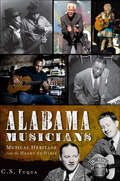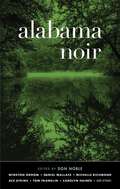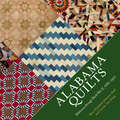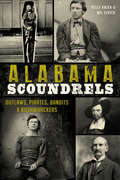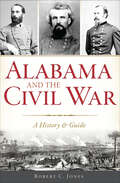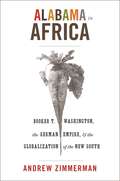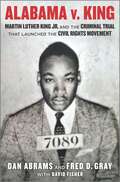- Table View
- List View
Alabama Musicians: Musical Heritage from the Heart of Dixie (Music Ser.)
by C.S. FuquaIn the late 1960s and early 1970s, legendary artists like Aretha Franklin, the Rolling Stones, Willie Nelson and Bob Dylan traveled to North Alabama to record with the Muscle Shoals Rhythm section, also known as the Swampers. But Alabama hasn't just attracted musical stars with its talent--it also has a history of creating stars of its own. Join author and musician C.S. Fuqua as he showcases the breadth of Alabama's musical talent through the profiles and stories of its historic performers and innovators. From the "father of the blues," W.C. Handy, to Hank Williams, the originator of modern country music, to folk music hero Odetta and everyone in between, this is an unprecedented compendium of Alabama's groundbreaking music makers.
Alabama Noir (Akashic Noir #0)
by Don NobleAkashic Books continues its award-winning series of original noir anthologies, launched in 2004 with Brooklyn Noir. Each book comprises all new stories, each one set in a distinct location within the geographic area of the book. Alabama joins Mississippi as fertile Deep South soil for the Noir Series. “The Good Thief” by Ravi Howard has been selected for inclusion in Best American Mystery and Suspense 2021! Brand-new stories by: Ace Atkins, Tom Franklin, Anita Miller Garner, Suzanne Hudson, Kirk Curnutt, Wendy Reed, Carolyn Haines, Anthony Grooms, Michelle Richmond, Winston Groom, Ravi Howard, Thom Gossom Jr., Brad Watson, Daniel Wallace, D. Winston Brown, and Marlin Barton. From the introduction by Don Noble: Some locales seem to come with their own soundtrack. Don Ho and his tiny bubbles provide the background music for Hawaii, Edith Piaf for Paris. The reggae of Bob Marley evokes Jamaica. The soundtrack for Alabama is without question provided by our troubled troubadour Hank Williams. The 2016 biography Hank by Mark Ribowsky paints a dark picture of the musician's short, alcoholic, drug-filled life: a life of loneliness and pain. He goes so far as to call Hank's life story "noir-ish"... In Alabama Noir we encounter "troubles and foibles" galore, darkness in many forms. The stories range from the deadly grim to some that are actually mildly humorous. We see desperate behavior on the banks of the Tennessee River, in the neighborhoods of Birmingham, in the affluent suburbs of Mobile, in a cemetery in Montgomery, and even on the deceptively pleasant beaches of the Gulf of Mexico. Fans of noir should all find something to enjoy.
Alabama Performance Coach, English Language Arts, [Grade] 3
by Triumph LearningNIMAC-sourced textbook
Alabama Performance Coach, English Language Arts, [Grade] 4
by Triumph LearningNIMAC-sourced textbook
Alabama Performance Coach, English Language Arts, [Grade] 5
by Triumph LearningNIMAC-sourced textbook
Alabama Performance Coach, English Language Arts, [Grade] 6
by Triumph LearningNIMAC-sourced textbook
Alabama Performance Coach, English Language Arts, [Grade] 7
by Triumph LearningNIMAC-sourced textbook
Alabama Performance Coach, English Language Arts, [Grade] 8
by Triumph LearningNIMAC-sourced textbook
Alabama Quilts: Wilderness through World War II, 1682-1950
by Mary Elizabeth Johnson Huff Carole Ann KingWinner of the 2022 James F. Sulzby Book Award from the Alabama Historical AssociationAlabama Quilts: Wilderness through World War II, 1682–1950 is a look at the quilts of the state from before Alabama was part of the Mississippi Territory through the Second World War—a period of 268 years. The quilts are examined for their cultural context—that is, within the community and time in which they were made, the lives of the makers, and the events for which they were made. Starting as far back as 1682, with a fragment that research indicates could possibly be the oldest quilt in America, the volume covers quilting in Alabama up through 1950. There are seven sections in the book to represent each time period of quilting in Alabama, and each section discusses the particular factors that influenced the appearance of the quilts, such as migration and population patterns, socioeconomic conditions, political climate, lifestyle paradigms, and historic events. Interwoven in this narrative are the stories of individuals associated with certain quilts, as recorded on quilt documentation forms. The book also includes over 265 beautiful photographs of the quilts and their intricate details. To make this book possible, authors Mary Elizabeth Johnson Huff and Carole Ann King worked with libraries, historic homes, museums, and quilt guilds around the state of Alabama, spending days on formal quilt documentation, while also holding lectures across the state and informal “quilt sharings.” The efforts of the authors involved so many community people—from historians, preservationists, librarians, textile historians, local historians, museum curators, and genealogists to quilt guild members, quilt shop owners, and quilt owners—making Alabama Quilts not only a celebration of the quilting culture within the state but also the many enthusiasts who have played a role in creating and sustaining this important art.
Alabama Scoundrels: Outlaws, Pirates, Bandits & Bushwhackers (True Crime)
by Kelly Kazek Wil ElrickWhile legislators were writing the first laws in Alabama, some miscreant citizens were already breaking them, causing disorder and fleeing the hands of justice. Among these were cult-leader-turned-murderer "Bloody" Bob Sims, social-activist-turned-anarchist Albert Parsons, the mysterious hobo bandit Railroad Bill and the nefarious outlaw sheriff Steve Renfroe, who was credited with countless prison escapes, thefts and arson. Legendary Wild West figures Frank and Jesse James also appeared in Alabama, along with numerous other well-known gunslingers, pirates, crooks and desperados. Bushwhackers caused widespread chaos during the Civil War and were considered outlaws depending on which side you supported. Join real-life partners in crime Kelly Kazek and Wil Elrick as they recount the atrocities of some of Alabama's most infamous lawbreakers.
Alabama Studies Weekly, [Grade] 4 Social Studies
by American Legacy Publishing Inc.NIMAC-sourced textbook
Alabama and the Civil War: A History & Guide (Civil War Ser.)
by Robert C. JonesAn examination of the influence of the &“Heart of Dixie&” on the War Between the States—the key players, places, and politics. Alabama&’s role in the Civil War cannot be understated. Union raids into northern Alabama, the huge manufacturing infrastructure in central Alabama and the Battle of Mobile Bay all played significant parts. A number of important Civil War figures also called Alabama home. Maj. General Joseph Wheeler was one of the most remarkable Confederate cavalry commanders in the west. John the Gallant Pelham earned the nickname for his bravery during the Battle of Fredericksburg. John Semmes commanded two of the most famous commerce raiders of the war—the CSS Sumter and the CSS Alabama. Author Robert C. Jones examines the people and places in Alabama that shaped the Civil War. Includes photos!
Alabama in Africa: Booker T. Washington, the German Empire, and the Globalization of the New South (America in the World #10)
by Angela Elisabeth ZimmermanIn 1901, the Tuskegee Institute, founded by Booker T. Washington, sent an expedition to the German colony of Togo in West Africa, with the purpose of transforming the region into a cotton economy similar to that of the post-Reconstruction American South. Alabama in Africa explores the politics of labor, sexuality, and race behind this endeavor, and the economic, political, and intellectual links connecting Germany, Africa, and the southern United States. The cross-fertilization of histories and practices led to the emergence of a global South, reproduced social inequities on both sides of the Atlantic, and pushed the American South and the German Empire to the forefront of modern colonialism. Zimmerman shows how the people of Togo, rather than serving as a blank slate for American and German ideologies, helped shape their region's place in the global South. He looks at the forms of resistance pioneered by African American freedpeople, Polish migrant laborers, African cotton cultivators, and other groups exploited by, but never passive victims of, the growing colonial political economy. Zimmerman reconstructs the social science of the global South formulated by such thinkers as Max Weber and W.E.B. Du Bois, and reveals how their theories continue to define contemporary race, class, and culture. Tracking the intertwined histories of Europe, Africa, and the Americas at the turn of the century, Alabama in Africa shows how the politics and economics of the segregated American South significantly reshaped other areas of the world.
Alabama v. King: Martin Luther King Jr. and the Criminal Trial That Launched the Civil Rights Movement
by Dan Abrams Fred D. GrayThe defense lawyer for Martin Luther King, Jr., Rosa Parks, the Selma marchers, and other civil rights heroes reveals the true story of the historic trial that made Dr. King a national hero. Fred D. Gray was just twenty-four years old when he became the defense lawyer for Dr. Martin Luther King, Jr., a young minister who had become the face of the bus boycott that had rocked the city of in Montgomery, Alabama. In this incredible history, Gray takes us behind the scenes of that landmark case, including such unforgettable moments as: *Martin Luther King's courageous response to a bomb threat on his own home*Poignant, searing testimony that exposed the South's racist systems to an worldwide audience*The conspiracy to destroy Gray's career and draft him into the Vietnam War*The unforgettable moment when a Supreme Court ruling brought the courtroom to a halt Alabama v. King captures a pivotal moment in the fight for equality, from the eyes of the lawyer who Dr. King called "the brilliant young leader who later became the chief counsel for the protest movement."
